
Q: What (courses/disciplines/values) do you teach?
A: I teach geology-mostly structural geology, tectonics, and field geology currently. I introduce students to features of the Earth's lithosphere like folds, faults and mountain belts. I have also taught introductory Earth science and sedimentary geology. About 10 years ago I helped to redesign the introductory Earth Science course EAS 100 to include not just the study of the solid Earth, but also the hydrosphere, atmosphere and biosphere. Teaching EAS 100 was a great experience for me; it gave me the opportunity to learn new things outside my usual field.
Q: Why should people learn about it?
A: The solid Earth is part of our heritage as humans. We evolved on its surface, under the influence a very active planet. All the resources we use come, in some way, from the Earth. But apart from the tangible benefits of exploring the Earth, I think we are intrinsically better off as human beings if we understand the history of our planet and how it works. It's part of our place in the universe.
 Q: What are some of its "real-world" applications?
Q: What are some of its "real-world" applications?
A: Practically speaking, understanding the structure of the Earth's crust has been important in the search for all kinds of resources, from water to hydrocarbons to minerals. Also, when we look at structures formed in the ancient parts of the Earth's crust, it helps us to understand some of the more dramatic processes that occur at the present day: events like earthquakes and landslides, that can have a devastating effect on people's lives.
Q: What's the coolest thing about this subject area?
A: The coolest thing for me is being able to look at the landscape and not just see what's on the surface, but to visualize how the rock units extend down and intersect below the surface in three dimensions. With that information, it's possible to figure out what took place-and in what order-during the history of that particular part of the Earth. Teaching students to visualize structures in three dimensions is one of the biggest teaching challenges, but it is also one of the most rewarding parts of my job.
Q: What's your favourite kind of teaching and/or learning space, and why?
A: My favourite place for teaching is definitely outdoors, either in the mountains or on shorelines, where the rocks are exposed. I find that when students are standing in the landscape it suddenly becomes much easier to understand 3-dimensional things than when they are sitting in a classroom.
I try to replicate some of the field experience with 3D visuals in my lectures, and by developing educational tools like the Geoscience Garden, but actually there's no real substitute for the field experience.
Q: What was your favourite learning experience as an undergrad, and how do you incorporate that experience into teaching your students?
"I think we are intrinsically better off as human beings if we understand the history of our planet and how it works. It's part of our place in the universe."
A: I remember several field courses. One particularly memorable one was through the highlands of Scotland, along a very famous fault zone called the Moine Thrust. It was a ridiculously rapid one-day trip through an area that other groups would spend a week or more studying. I remember the trip was in cars or vans and my professor was driving; I had the detailed geological map on my lap and gave a running commentary about which layers and structures could be seen on which of the mountainsides that surrounded us. I realize now that I was learning and teaching at the same time, which is a great experience. I try to incorporate this kind of experience-both for myself and my students-into my courses whenever I can.
Q: What is one thing that people would be surprised to know about you?
A: My PhD research was on an area of SW Turkey, and I spent a total of over eight months in Turkey over three summers in the late 1970s. I worked on my own or with a driver provided by the Turkish geological survey, so I had no-one to talk to in English. With help from a phrase book and a dictionary-and some very patient Turkish friends-I taught myself a bit of conversational Turkish which I have never lost, so I can still introduce myself and order a meal in Turkish in a Turkish restaurant. It's a neat language-totally logically spelled and with no irregular verbs at all. Apart from the geology, that was one of the most rewarding experiences of my life as a student.